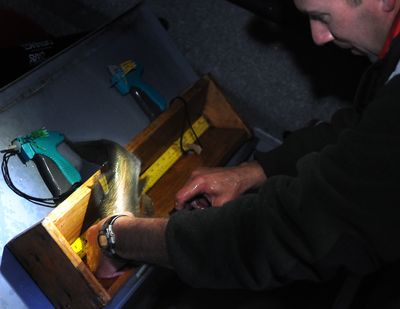Redband fighting for survival
Fish a measure of river’s health

The fish thrashed in Jason McLellan’s grip, its olive-green body a blur. Distinctive scarlet bands – visible in flashes – ran down its sides.
“Relax, relax,” said McLellan, a fisheries biologist, as he measured and weighed the trophy-size redband trout. “You’re too feisty.”
Redband are known for their fighting attitude, but native fish are struggling to survive in the Spokane River. To gather data about declining redband populations, McLellan and other Washington Department of Fish and Wildlife colleagues are spending nights on the river in a research boat.
As dusk turned into darkness last week, McLellan and fellow fish biologist Rod O’Connor launched a 16-foot aluminum drift boat beneath the Stateline bridge. It was 7 o’clock. Reflections from a full moon glinted on the water, while the neon sign from Cabela’s sporting good store cast a golden glow across the sky.
The drift boat prowled the shallows near the shoreline. Spider-like probes extended from the front of the boat, emitting an electrical current that extended 10 feet. As fish swam toward the electrical current, it briefly stunned them, allowing McLellan to scoop the surfacing fish out of the water. O’Connor navigated the craft.
The shock method works better at night. Biologists get higher capture rates in the dark because the fish aren’t spooked by the approaching boat, McLellan said.
During the night’s work, the co-workers counted 18 redband trout and 25 smallmouth bass on a six-mile stretch of the upper Spokane. Bass prey on juvenile trout, so researchers count them, too. Each captured fish swam away with a small identification tag inserted near its dorsal fin.
The fish census will help biologists track population trends.
“It’s like the Dow Jones industrial average,” said Chris Donley, a Fish and Wildlife district fisheries biologist. “You get a baseline you can use for comparison.”
The redband index – like the Dow Jones – is headed south. On one stretch of the upper Spokane, redband counts dropped 75 percent between 1980 and last year. Though downstream counts are higher, redband populations aren’t healthy in any part of the river, Donley said. The declines have occurred despite two decades of catch-and-release regulations for anglers.
Smallmouth bass are one factor in the redband’s demise. Illegally introduced to Lake Coeur d’Alene, they’ve spread into the Spokane River, where they feed on young trout. But the overall picture for redbands is much more complex, Donley said.
Redbands are a subspecies of rainbow trout. For thousands of years, they thrived in the river, evolving with natural cycles of snowmelt and high spring flows. But hydropower dams altered the river’s flows, while withdrawals sucked water out of the river. Gravel spawning beds, where redbands lay their eggs, dry out too soon, killing the young fry.
Pollutants also hurt the trout. More than other fish in the Spokane system, redbands need cold, clean water for survival.
“They’re the canary in the coal mine,” Donley said. “We use them as an environmental indicator.”
In addition to being a critical part of the aquatic ecosystem, redbands are fun to catch, Donley added. Anglers prize their fight on the end of a line. No one wants to see them disappear, he said.
“You don’t want to close the door on your career,” Donley said, “and have everyone remember, ‘That guy caught the last redband trout in the Spokane River.’ ”
McLellan and O’Connor will wrap up the redband surveys this week. One promising piece of data: McLellan is netting more yearling trout. Last year most of the redbands he caught were 3 or older, raising concerns about reproduction rates and the chances for survival of younger fish.
Last week, freeway lights flickered to the south as O’Connor rowed across the Spokane River. Before their shift ends at midnight, the men often hear the lonely howl of a coyote. Sometimes, they glimpse one skulking in the shadows.
The riverbanks rise below Sullivan Road, creating a canyon-like feel. Freeway sounds and city lights fade away.
“It’s peaceful,” McLellan said. “When you’re out here at night, it’s hard to remember that you’re in an urban setting.”